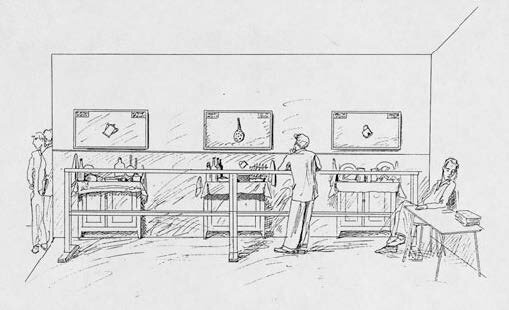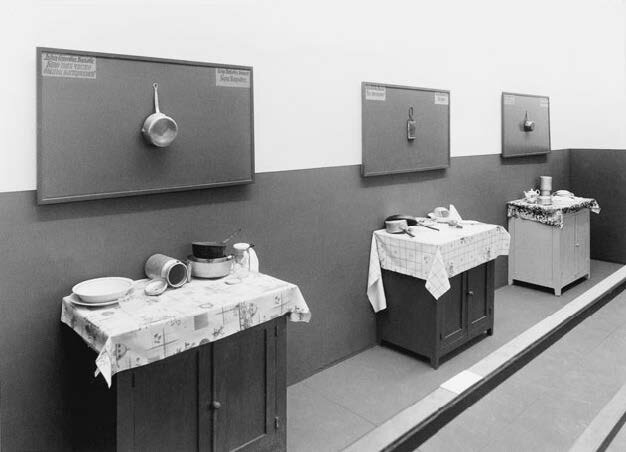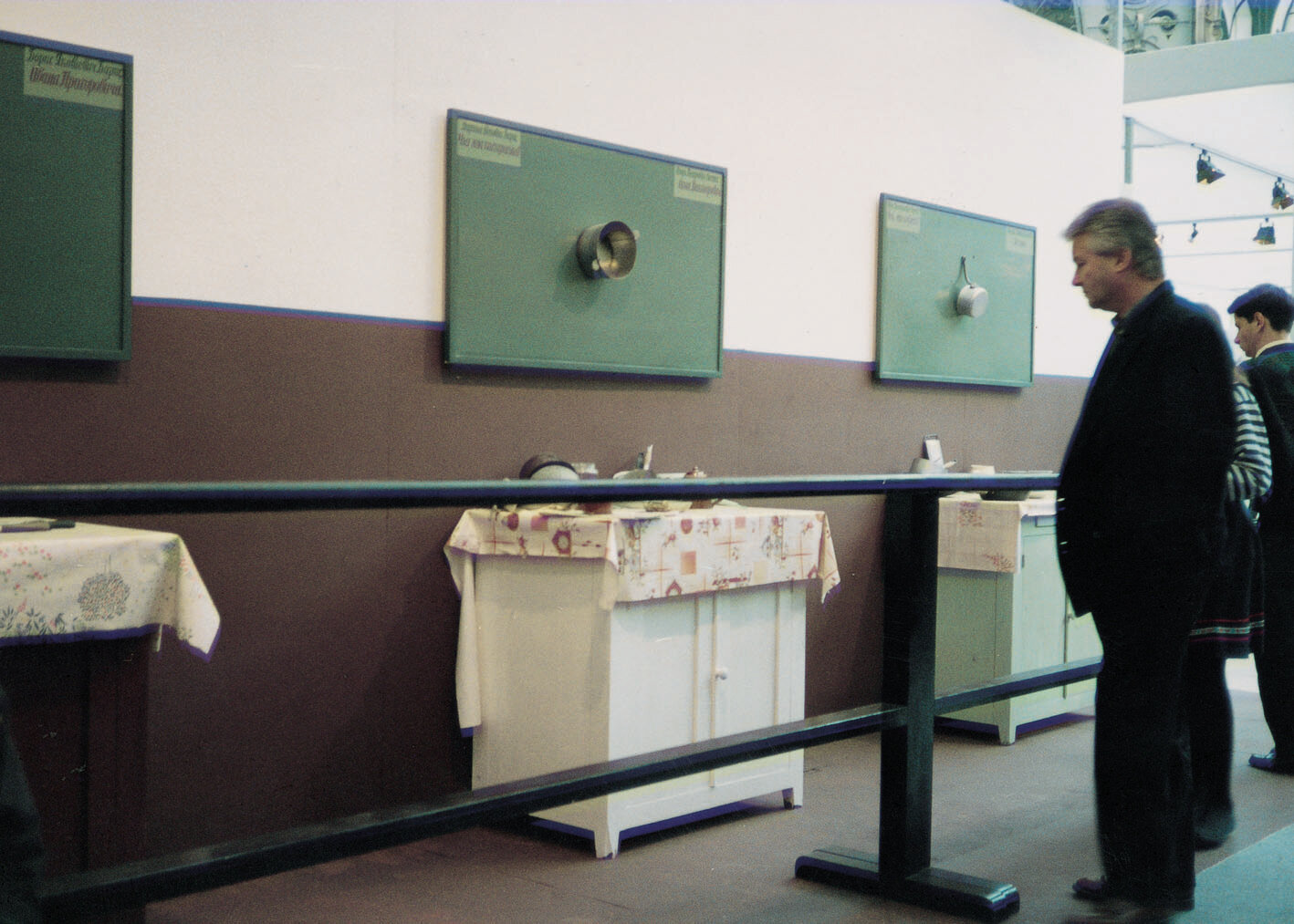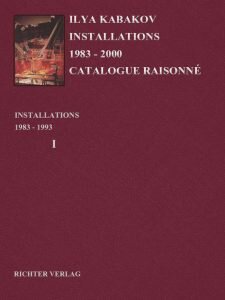In the Communal Kitchen
YEAR: 1991
CATALOGUE NUMBER: 52
PROVENANCE
The artist
Collection Dina Vierny, Paris
EXHIBITIONS
Paris, Galerie Dina Vierny
FIAC ’9, 1 5 Oct 1991 — 13 Oct 1991
Groningen, Groninger Museum
Ex USSR. Hedendaagse Kunstenaars uit het GOS, 23 Feb 1992 — 20 Apr 1992
Hamburg, Eichtorhallen
Ilya Kabakov. Der Lesesaal – Bilder, Leporellos und Zeichnungen, 19 Apr 1996 — 28 Jul 1996 (as part of No 90, The Reading Room)
Salamanca, Centro de Arte de Salamanca
Comer o no comer, 23 Nov 2002 — 19 Jan 2003
NOTES
See No 90
DESCRIPTION
This installation was made specifically for the Dina Vierny pavilion at Fiac 1991 and was limited by the pavilion’s size of 6 x 4 meters. It consisted of six cupboards that were leaning up against the walls on three sides and with paintings from ‘The Kitchen Series’ hanging above each of them. All of this taken together formed a brown, repulsive border running along the lower part of the walls, with a similar floor, only darker, under these cupboards that were arranged right up against one another. The multitude of dishes on the tables and in the ‘paintings’ – all of this was supposed to create a certain ‘image’ of a ‘communal’ kitchen, of communal life. The pair, the combination of the natural cupboard and the painting above it, was interesting. The cupboard was done entirely realistically, it could have been ‘sold’ to any kitchen: the doors opened and there were shelves inside. It was covered by a cheap vinyl, and standing on it was the typical assortment of things left by a ‘tidy’ housewife: grains in closed containers, everything is cleanly washed, wiped off, a towel hangs on a nail in the wall intended just for that purpose. Having such a reservoir of naturalism ‘down below,’ it might seem that the green board hung on the wall along with kitchen utensils nailed to it (and this is virtually all there is on this painting), should also be perceived as an entirely natural object of everyday life (a board for kitchen items). But this didn’t happen, and any viewer saw that there was a cabinet down below and a painting above it, a strange one but still a ‘painting,’ everything had its ‘normal’ aesthetic effect. I wracked my brain for a long time afterward, trying to figure out where such an aesthetic ‘naturalness’ of the pair described here came from (the concept of this installation occurred to me unexpectedly, I ‘saw’ it and made it, but I didn’t really pay any attention to why it was this way), when suddenly, a year later, when I was in the city museum of Utrecht I saw ‘my cupboard and my painting.’ How I didn’t guess this at first is surprising, for after all, this was the oldest, most traditional combination – a cupboard or tall trunk covered with expensive cloth holding a valuable crystal vase or some marble thing, and then above all of this hung a beautiful painting in a golden frame – this ‘duet’ was an obligatory part of the interior of any wealthy household of the 15th-16th- 17th centuries, and in any ‘bourgeois’ household today.
I had merely guessed at the proportions, the height and size of each participant, completely blindly and intuitively. All I had to do was to find (also intuitively) the height of the ‘painting’ above the cupboard, and this situation coincided precisely with the image that lived in the depths of any viewer’s consciousness. More I had merely guessed over, it was not at all important that in place of an old masterpiece by an old master there was a crooked thing made of plywood, and instead of Ruisdael or Hobbema, there was an empty board painted a dull green with a dented coffeepot in the center and two texts in some foreign language to the right and left above the top plank.
Description of the Paintings
The entire group of 10 boards with objects attached is called ‘The Kitchen Series.’
Each board resembles an instructional aid with medical, fire prevention, and other objects that must be studied so one might know how to use them. As a whole, this is a kind of utilitarian ‘stand,’ and accordingly, it is painted with ‘generic’ paint and neatly framed.
But this board is for kitchen items on which are hung meat grinders, colanders, graters, knives … The recordings of two voices, if these ‘voices’ resound, are placed in the two corners. This means that the green-gray background is not really a plane, but rather a ‘kitchen’ space in which they can be heard.
All 10 boards, when hung in one or two rows, should form an exhibit, and in this way, the viewer will hear the voices of 14-15 people resounding at the same time.
One’s memory immediately evokes recollections, circumstances, where this might occur – voices in a ‘communal’ kitchen, where in one place a number of stoves burn simultaneously, and along the walls, there are small kitchen cupboards standing flush up against one another, painted different colors and maintained to lesser or greater degrees. There is the same number of cupboards as there are rooms in the communal apartment, and each ‘resident’ stands at his or her cupboard, chopping, cutting and cooking. Above each table are ‘stands’ with towels, pots and pans, knives. The personal exposition is completed by a ‘front shelf’ of cups, dishes, jars …
Conversations in this place are not at all like dialogues. Each person present, it seems, tosses out phrases simply into emptiness, as though not really addressing anyone in particular. But it is a strange thing that in some mysterious way a phrase tossed out ‘nowhere’ finds a response in the other end of the kitchen, someone will definitely ‘answer.’ Someone will say something that is semi-affirmative, or inquisitive, after a while, as if waiting a bit, anyone will comment on what was said with the same short kind of phrase (of course, this doesn’t happen when for some reason, someone begins a long and passionate monologue).
The entire matter is that during many years of standing in this kitchen, like in the square of a medieval city, all the thoughts and words that were ever uttered here accumulate in the air along with the thick layer of diverse aromas, and all you have to do is to utter two or three phrases and this whole field comes to life, it almost begins to move. The entire repertoire of these half-questions/half-responses, the entire ‘tonal’ nuance, the intonation of these phrases, emanate from this ‘field,’ from these rich few cubic meters of ‘air’ under the ceiling that is filled with steam and dense smells.
The words pronounced by people standing down below spill into this ‘field,’ they add something to it, they combine with it, they seek out their words-responses in it. What results is the existence of a kind of special ‘noosphere’ as described by Vernadsky.
If we return to the paintings of the ‘The Kitchen Series,’ then we find that this very same board with the kitchen objects nailed to it can be understood by the viewer in two ways: in the first place, it is a dirty, repulsive kitchen object and the board under it is just as disgusting; or secondly, this board is the main character and represents the murky, thick space of a kind of dusty corner in which voices-phrases resound that come from many corners, they hang in the air and remain their forever, just like this dreary lonely object in the center of the board. In this case, in relation to the viscous, gray-green field, both the word and the object become one and the same…
… Speaking in a bombastic language, what results in the first instance is a foul everyday object; in the second instance, what results is almost a metaphysical space of some sort …
Images
Literature







